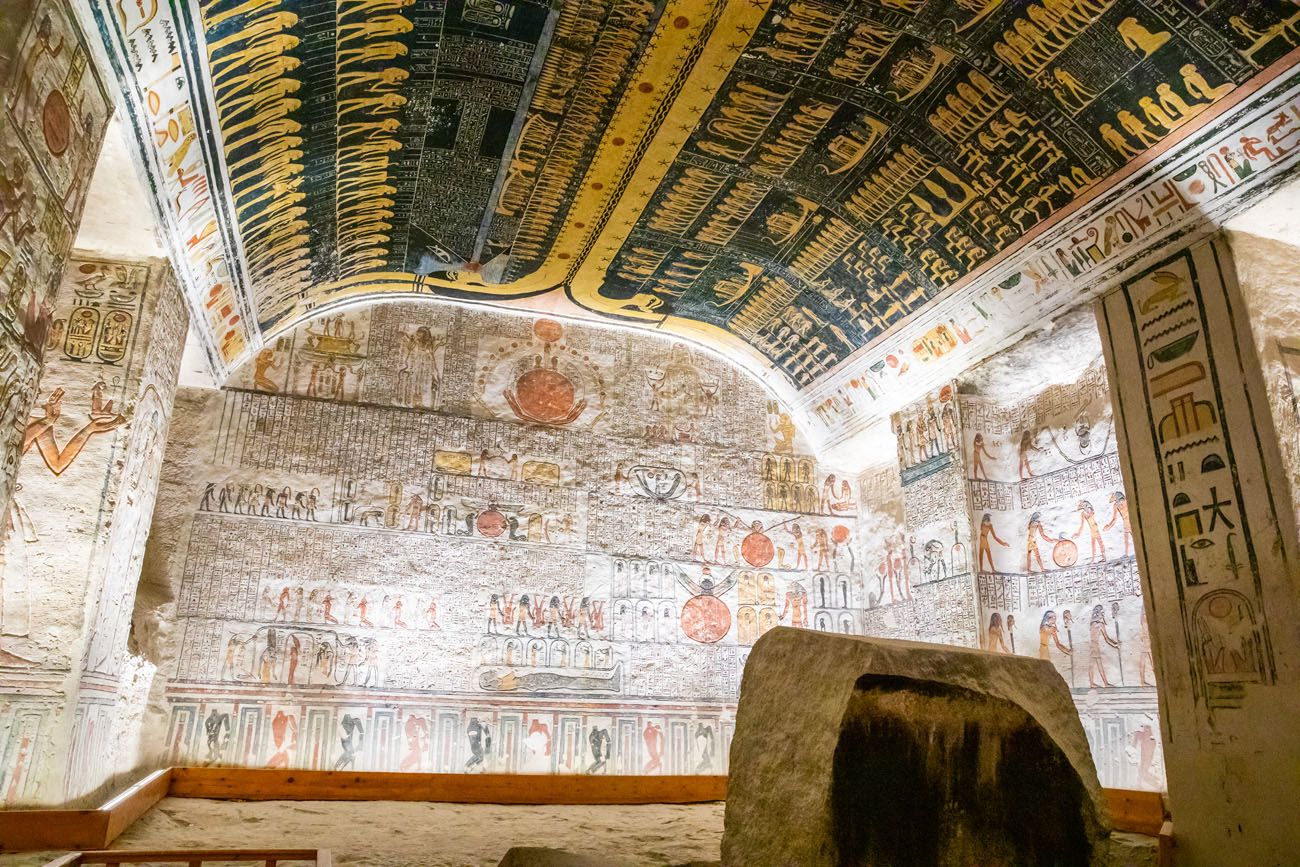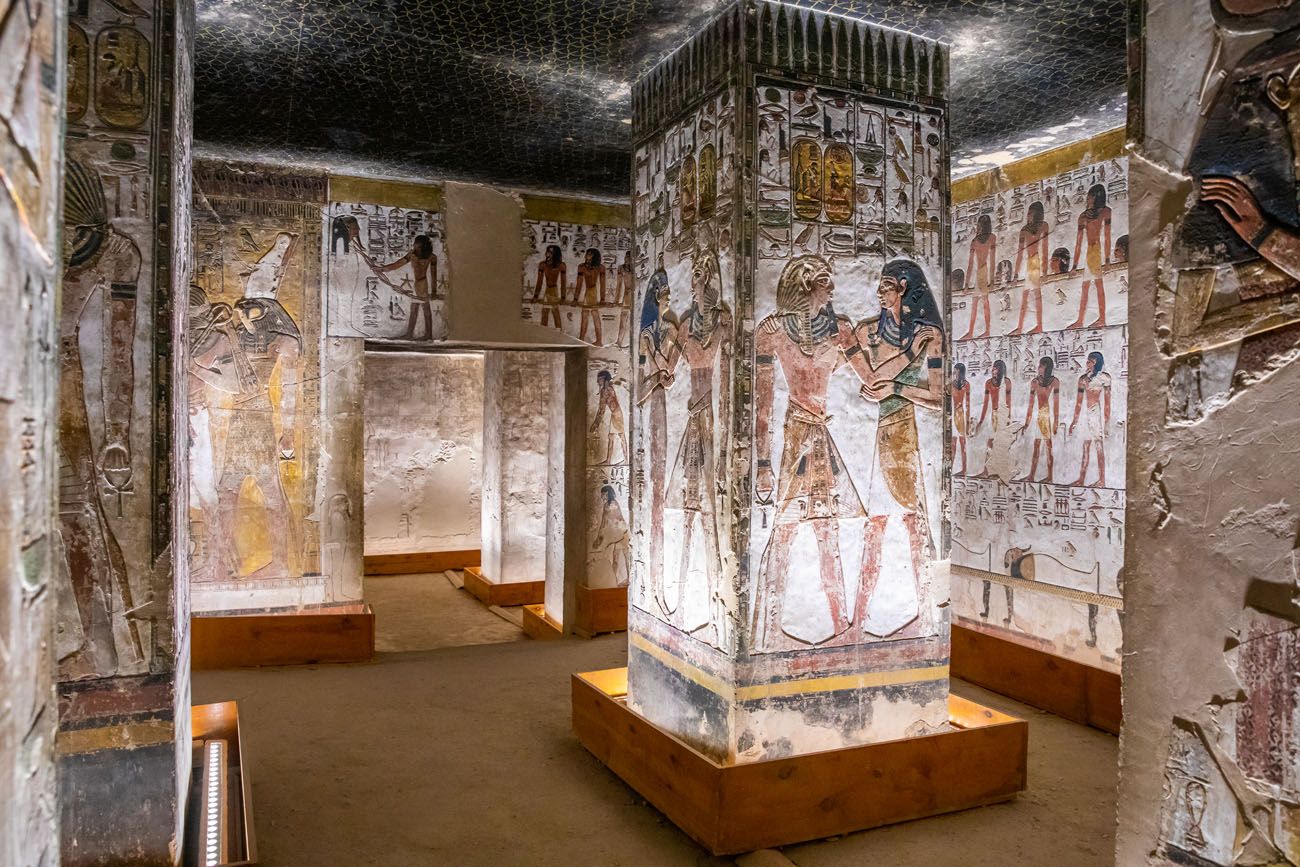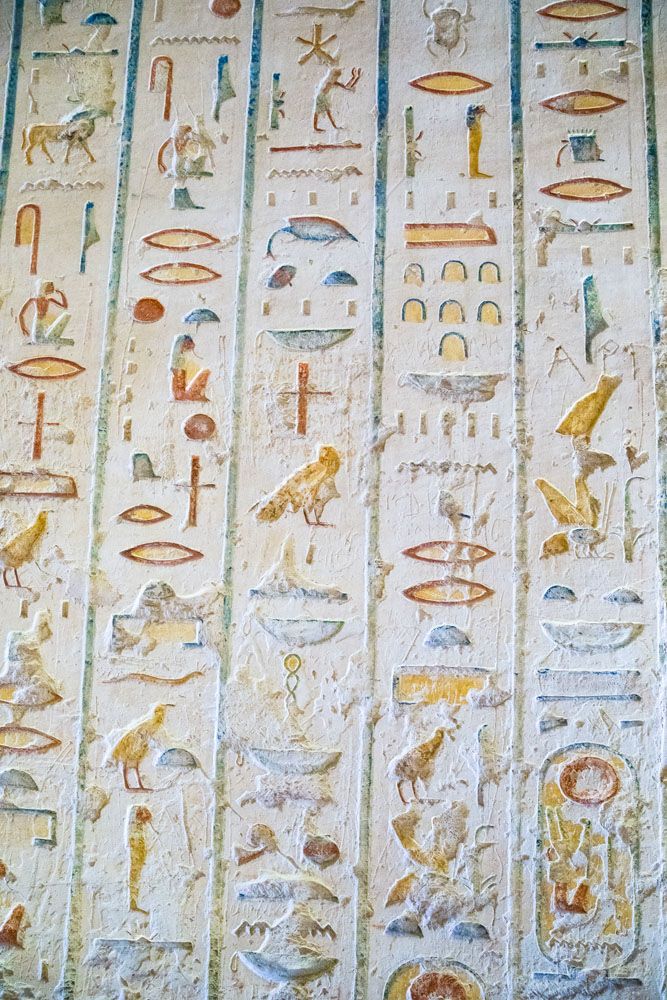The Valley of the Kings is one of the most famous archaeological sites in the world. This is a royal burial ground, with exquisitely decorated tombs for the pharaohs who ruled Egypt between 1539 and 1075 BC. There are over 60 tombs in this small area, although only a handful are open to public. If you are planning a visit to Egypt, here are the best tombs to visit in the Valley of the Kings.
About the Valley of the Kings
The Valley of the Kings is a burial ground for pharaohs who ruled Egypt during the 18th, 19th, and 20th dynasties (the New Kingdom of Egypt). Famous kings from this time period include Tutankhamun, Ramses II, Tuthmosis III, and Seti I, as well as Queen Nefertari, powerful nobles, and the wives and children of the pharaohs.
The tombs are labeled with the abbreviation “KV,” which stands for Kings Valley. The labeling starts with KV1 (Ramses VII) and goes up to KV65. However, this will change if another tomb is discovered (which is very likely).
Of the 60+ tombs in the Valley of the Kings, there are only a few that are open to the public.
Tombs That Are Open to the Public
Currently, ten tombs are included on the main ticket into the Valley of the Kings. Your entrance ticket will allow you to visit three of these tombs. If you want to see more than three tombs, you will have to purchase an additional ticket.
Here are the ten tombs that are available to visit with the main entrance ticket:
KV1 – Ramesses VII
KV2 – Ramesses IV
KV6 – Ramesses IX
KV8 – Merenptah
KV11 – Ramesses III
KV14 – Tausert-Setnakht
KV15 – Sety II
KV16 – Ramesses I
KV43 – Thutmose
KV47 – Siptah
There are three additional tombs that you can visit with an extra ticket. Here is the list with the additional price for each tomb.
KV9 – Ramesses V & VI 180 EGP per person
KV17 – Seti I 1,800 EGP per person
KV62 – Tutankhamun 500 EGP per person
PRO TRAVEL TIP: The tombs that are available to visit change periodically. Some tombs may close for renovation and another tomb will open to the public. This list is accurate as of January 2024, but if you visit the Valley of the Kings and notice anything different, you can let us know in the comment section below. It would be a big help to future readers. Thanks!
About the spellings in this article: Spellings of the names of the kings and queens can vary according to the source. For example, the name for Tausert, a female ruler during the 19th dynasty, can also be spelled Twosret, Tawosret, and Tausret. The name Ramesses can also be spelled Rameses or Ramses. In this article, I primarily use the spelling found on the signs at each tomb entrance.
If you are planning a visit to Luxor, don’t miss our Guide to the Valley of the Kings. This article includes all of the practical details you need to know to plan your visit, including cost, photography rules, how to get here, what to expect on your visit, and much more.
Best Tombs to Visit in the Valley of the Kings
Here is a list of the best tombs to visit in the Valley of the Kings, ranked from our favorite to our least favorite. At the end of the list, I will give you two more recommendations for tombs that were not open during our visit. If you are lucky enough to visit the Valley of the Kings when either of these temples are open, it is worth it to add them to your list.
Ramesses V and VI
Requires an extra ticket: 220 EGP
This was my favorite tomb in the Valley of the Kings. It is one of the largest tombs, featuring a very long hallway and several series of staircases. The pillared hallway, at about the midpoint of this tomb, is breathtaking. The burial chamber is enormous and the astronomical ceiling is decorated with the book of the Heavens, showing the daily regeneration of the solar disc.
For only an additional 220 EGP (about $4 USD), this is definitely worth the small extra expense.






KV 17 – Seti I
Requires an extra ticket: 2000 EGP
This is one of the deepest and most vibrantly colored tombs in the Valley of the Kings. It was discovered in 1817 by Giovanni Belzoni and is sometimes referred to as “Belzoni’s tomb.”
Many visitors state that this is the best tomb to visit in the Valley of the Kings. With its big price tag, it better be spectacular, right?
This tomb features several long, exquisitely decorated passageways and two pillared rooms. The passageway ends at the massive burial chamber that is adorned with colorful scenes on the walls and an astronomical scene on the ceiling.
In this tomb, you can also see an unfinished room, with the planned reliefs sketched in red and black ink.







KV2 – Ramesses IV
Included on the entrance ticket.
This was our favorite tomb that is included on the main ticket to the Valley of the Kings. The hallway is long and beautifully detailed. The tomb is also very elaborate, with colorful images that cover the walls and ceiling.
The main passageway and antechamber are decorated with scenes from the Book of Caverns and the Book of the Dead. This was used as a church for a short period of time and it is possible to see Coptic graffiti in this tomb.





KV11 – Ramesses III
This is one of the largest tombs in the Valley of the Kings. Long passageways, with detailed artwork that is protected behind glass, lead down to the burial chamber. There is a lot to see in this tomb and it was very uncrowded during our visit.






KV 62 – Tutankhamun
Reguires an extra ticket: 700 EGP
King Tutankhamun died at the very young age of 19. He reigned Egypt for only 10 years. His is the smallest of the tombs you can visit in the Valley of the Kings, but when it was discovered by Howard Carter in 1922, it contained the largest and most elaborate collection of artifacts of any tomb in the valley.
In this tomb, you can see the mummified body of King Tut and the burial chamber which contained his gilded shrines. Many of the artifacts found in this tomb are on display in the Egyptian Museum.


KV 14 – Tausert and Setnakht
Included on the main entrance ticket.
This is the largest tomb in the Valley of the Kings. It contains two tombs, the first one for Queen Tausert. King Setnakht usurped Tausert’s tomb, enlarging it and adding several lower passageways and a pillared hall for his burial chamber.






KV6 – Ramesses IX
Included on the entrance ticket.
Ramesses IX is another beautiful tomb in the Valley of the Kings. Similar to the tomb of Ramesses IV, you walk down a long, elaborately decorated passageway to the tomb. Along this passageway, you can see the Book of the Dead. The walls are protected with glass.
The hallway ends at a viewpoint of the burial chamber, which is decorated with a figure of the king and more detailed images.



KV 15 – Seti II
Included on the main entrance ticket.
This tomb features a passageway that features low reliefs with the Litany of Ra. The lower passageways have less artwork on the walls. A final descent down a staircase through a beautifully decorated room of pillars takes you to the burial chamber where you can see the sarcophagus of Seti II.




KV8 – Merenptah
Included on the entrance ticket.
Merenptah lacks a lot of the detailed artwork and reliefs that you can see in the other tombs. It’s a downhill walk through a long passageway where some of the walls are barren and some of the walls contain images of King Merenptah with the god Ra-Horakhty. The passageway ends a large burial chamber. The mummy of Merenptah resides inside the Egyptian Museum.



The Tombs of Ramesses I, Thutmose and Siptah
There are four tombs that we did not visit, Ramesses VI (KV1), Ramesses I (KV16), Thutmose (KV43), and Siptah (KV47). From what we read online prior to our visit, Siptah sounded rather mediocre. Many of the passageways in Siptah are undecorated and the burial chamber is unfinished, according to the books that I purchased at the Valley of the Kings.
Since our visit, the tombs of Ramesses I (KV16), Ramesses VII (KV1), and Thutmose (KV43) opened. If you have visited these tombs and want to write in with your experience, you can do so in the comment section below.
Two Additional Recommendations
These next two tombs were not open during our visit. However, from what I read online and from talking to our guide, these two tombs are spectacular. If one (or both) of these tombs are open during your visit, add them to your list instead of one or two of the other tombs listed on the included ticket.
KV 57 – Horemheb
This is one of the deepest tombs in the Valley of the Kings. Undecorated corridors lead down into the burial chamber. The burial chamber is decorated with vibrantly colored images of the king appearing with Isis, Osiris, Hathor, and Anubis.
Horemheb was the last pharaoh of the 18th dynasty of Egypt.
KV 34 – Tuthmosis III
From what I read online, this is one of the most spectacular tombs in the Valley of the Kings. However, it has not been open in years.
This tomb was discovered in 1898. The burial chamber is designed in the shape of a large cartouche. The ceiling is decorated with yellow stars on a dark blue background. The walls of the burial chamber are covered with scenes of the first complete version of the Amduat, or “That Which is in the Underworld.”
Which Tombs do We Recommend?
Of the ten tombs that are included on the main entrance ticket, KV2 (Ramesses IV), KV 14 (Tausert and Seknakht), KV11 (Ramesses III), and the tomb of Ramesses IX (KV6) are our favorites.
I think that it is absolutely worth it to spend 220 EGP to visit the tombs of Ramesses V and VI.
If you want to see the mummy of King Tut, then it is worth it for 700 EGP. However, the tomb is nothing special and you can see better preserved mummies at the Egyptian Museum.
Is the tomb of Seti I worth 2200 EGP? That depends. In US dollars, that’s about $43 just to visit one tomb. However, it is spectacular. Many people who see it state that it is the best tomb to visit in the Valley of the Kings. For many people, this is a huge splurge. It was for us too (factoring in the larger exchange rate in 2019, it was about $70 USD), but I am very glad that we got to see it.
Just so you are aware, there is another, even more spectacular tomb on the west bank of Luxor, the amazing tomb of Queen Nefertari, which is located in the Valley of the Queens. This tomb also has a large price tag of 2000 EGP. If you are trying to decide between Seti I and Queen Nefertari, we recommend Queen Nefertari. However, the Tomb of Nefertari closed March 2, 2024 with no information about when it will reopen.
I don’t think that it is necessary to purchase two entrance tickets into the Valley of the Kings in order to visit six included tombs. I recommend picking three from this list and saving your time and money for other sites on the West Bank. In all honesty, the tombs get to be repetitive, so visiting three included tombs and the additional extra tombs is all that most visitors will need here.
You can get updated pricing and purchase your entrance tickets in advance on the egymonuments website.
In summary, pick three included tombs. The extra expense for the tomb of Ramesses V and VI is worth every penny. Only pay the fee to enter Tutankhamun’s tomb if you want to see his mummy. Seti I is worth it if you have the money to spend.
In case you missed it, here is the link to our guide on how to visit the Valley of the Kings. It includes lots of advice and practical information you need to know to plan your visit.
About Our Visit to Luxor
We spent four days in Luxor at the end of December, 2019. On this trip, we were a group of six, since our mothers, Kathy and Valerie joined us. Because of the enormous amount of sites to visit, we visited the West Bank twice.
For our visit to Luxor (and for many of the places we visited in Egypt), we hired the company Egypt Tailor Made. We chose Egypt Tailor Made based on their impeccable reviews on Trip Advisor.
From start to finish, our experience with Egypt Tailor Made was fantastic. Tim communicated with the owner of the company by email to customize their day tours into our itinerary. In Luxor and Aswan, we had a van and a private driver which took the hassle out of arranging our transportation. Our guides for both Luxor and Cairo were very knowledgeable.
I highly recommend Egypt Tailor Made if you want personalized service for your trip to Egypt. You can string together their day tours or customize them into your own personal itinerary.
If you have any questions about the best tombs to visit in the Valley of the Kings, or if you want to share your favorites, let us know in the comment section below.
More Information about Egypt
LUXOR: In our guide Best Things to Do in Luxor, get an overview of places to go on the East Bank and West Bank. We also have a photo tour of the Tomb of Queen Neferatari, a guide to the Valley of the Kings, and how to day trip to Dendera and Abydos.
ABU SIMBEL: In our guide to Abu Simbel, we cover what you need to know to plan your day trip.
TRAVEL ADVICE: Here is list of important things to know before visit Egypt. The Luxor Pass and Cairo Pass can save you a lot of money…learn more in our guide. And we also have information on how much it costs to visit Egypt.
EGYPT ITINERARY: With 10 days in Egypt, visit Cairo, Luxor, Aswan and Abu Simbel.
PYRAMIDS OF GIZA: Plan your visit with our article How to Visit the Pyramids of Giza. We also have an article about where to get the best views of the pyramids.
Read all of our articles about Egypt in our Egypt Travel Guide.

Note: This post contains affiliate links. When you make a purchase using one of these affiliate links, we get paid a small commission at no extra cost to you.
All rights reserved © Earth Trekkers. Republishing this article and/or any of its contents (text, photography, etc.), in whole or in part, is strictly prohibited.



Comments 40